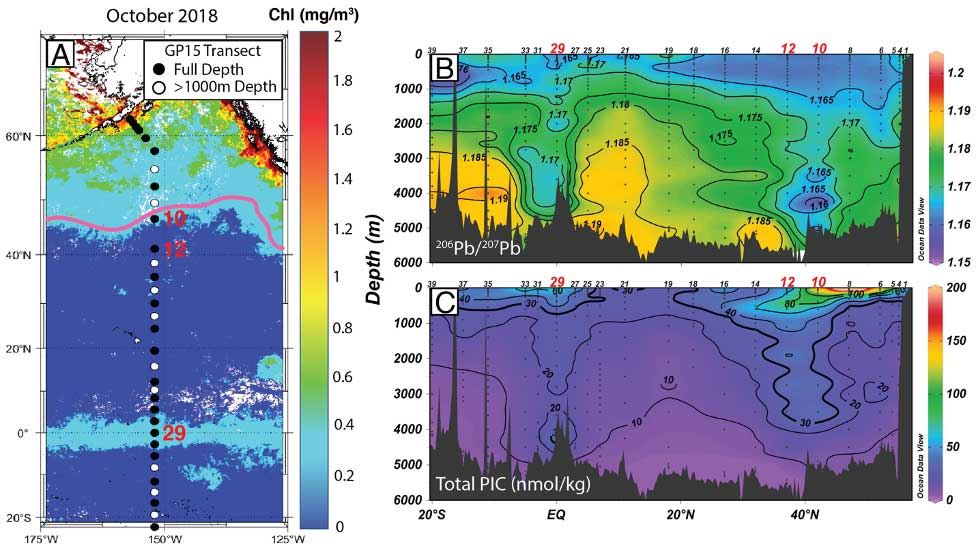Pulling back the veil on reversible scavenging of lead
For decades, the ratios of stable dissolved Pb (dPb) isotopes (206Pb/207Pb & 208Pb/206Pb) have been used to trace the origin of oceanic dPb capable of distinguishing anthropogenic versus natural sources. In the modern North Pacific, anthropogenic dPb input from Asia is the dominant Pb source to the upper ocean, exhibiting a characteristic isotope signature. Intriguingly, dPb concentrations deep in the North Pacific water column have also been progressively increasing. This is hypothesised to result from intense scavenging of anthropogenic dPb isotopes to sinking particles in the upper ocean with subsequent ‘reversible-scavenging’ desorbing Pb back into the dissolved phase of the deep ocean as the particles sink. Although this mechanism has been previously hypothesised (Boyle et al., 1994; Wu et al., 2010), Lanning et al. and his peers have observed how changes in scavenging intensity & particle loading influence this isotope exchange on a basin-scale.
These authors assessed the role of particle-rich ‘veils’ in the vertical transport of anthropogenic dPb isotopes using the GEOTRACES GP15 transect occupation of the Equatorial & North Pacific veils (Lanning et al., 2023). Only within the particle veils do anthropogenic dPb isotope ratios extend from the upper ocean to the seafloor, overprinting on the background pre-industrial water column isotope signatures. These isotope effects coincide with elevated particulate inorganic carbon (PIC) and suspended particulate matter, emphasizing the importance of high particle-loading to facilitate sufficient isotope exchange. A simple 1-D box model was implemented to quantify how only within high-flux veils is reversible dPb isotope exchange between the particulate and dissolved phases fast enough to supply anthropogenic dPb from the upper ocean to depth.
This work further contains the role that reversible scavenging may play in the cycling of Pb in the ocean, an ever-evolving global experiment where Pb contamination can be tracked in real-time. The innovations of this work have been summarised in a commentary (Bridgestock, 2023).

References:
Boyle, E. A., Sherrell, R., & Bacon, M. (1994). Lead variability in the western North Atlantic Ocean and central Greenland ice: Implications for the search for decadal trends in anthropogenic emissions. Geochimica et Cosmochimica Acta, 58(15), 3227-3238. Access the paper: https://doi.org/10.1016/0016-7037(94)90050-7
Bridgestock, L. (2023). Lead contamination of the deep Pacific Ocean via exchange with sinking particles. Proceedings of the National Academy of Sciences, 120(26). Access the paper: https://dx.doi.org/10.1073/pnas.2308014120
Lanning, N. T., Jiang, S., Amaral, V. J., Mateos, K., Steffen, J. M., Lam, P. J., et al. (2023). Isotopes illustrate vertical transport of anthropogenic Pb by reversible scavenging within Pacific Ocean particle veils. Proceedings of the National Academy of Sciences, 120(23). Access the paper: https://www.pnas.org/doi/10.1073/pnas.2219688120
Wu, J., Rember, R., Jin, M., Boyle, E. A., & Flegal, A. R. (2010). Isotopic evidence for the source of lead in the North Pacific abyssal water. Geochimica et Cosmochimica Acta, 74(16). Access the paper: https://doi.org/10.1016/j.gca.2010.05.017
